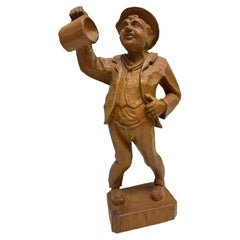Austrian Beer Stein
Vintage 1960s Austrian Black Forest Sculptures and Carvings
Wood
People Also Browsed
2010s Folk Art Figurative Sculptures
Wood
Early 20th Century British Neoclassical Sterling Silver
Sterling Silver
Vintage 1920s French Art Deco Figurative Sculptures
Marble, Bronze
Mid-20th Century German Mid-Century Modern Dinner Plates
Porcelain
21st Century and Contemporary Spanish Modern Animal Sculptures
Metal
19th Century Academic Landscape Paintings
Oil
Albert Bierstadt, 1830-1902"In the Canadian Rockies" 19th Century Oil Painting on Canvas, Circa 1866
Vintage 1960s Italian Table Lamps
Glass
Vintage 1920s Decorative Bowls
Art Glass
Antique Late 18th Century English British Colonial Tableware
Pewter
2010s French Modern Outsider and Self Taught Art
Metal
20th Century Austrian Folk Art Toys and Dolls
Composition
Early 20th Century Industrial Cabinets
Brass, Steel
Vintage 1960s German Mid-Century Modern Vases
Porcelain
21st Century and Contemporary American Glass
Glass
2010s Contemporary Figurative Paintings
Linen, Acrylic
Antique 1880s French Art Nouveau Side Tables
Bronze
A Close Look at Black-forest Furniture
Although its name evokes a mountainous region in Germany, antique Black Forest–style furniture originated in Switzerland. In Brienz, during the early 19th century, wood-carver Christian Fischer recognized the market for tourist souvenirs and helped make the village into a wood-carving destination. The Brienz Woodcarving School was founded in 1884 and had its own small zoo for studying the anatomy of animals, depictions of which are a defining aspect of the style, also known as Brienzerware.
Whimsical sculptures, often depicting bears and other Alpine animals like stags, owls, deer and boars, characterize the work produced in the area. Along with folk art and decorative objects, Black Forest furniture included benches held aloft by bears, umbrella stands carved with acorns and clock cases adorned with scrolling oak leaves. While most wood-carvers adhered to a similar realism in their designs and woods like linden, maple and walnut, their aesthetics varied.
The F. Peter Trauffer family was known for their hand-carved bear sculptures that saw the furry mammals playing instruments, smoking pipes and engaging in all sorts of human activities. They were sometimes detailed with glass eyes and integrated into functional pieces of furniture, including chair backs and bench legs, which generations of cabinetmakers created from the 1880s to the 1950s. Walter Mader and his son Heinrich frequently carved Saint Bernard sculptures that they incorporated into furniture.
As the Black Forest furniture style spread around the world through exhibitions at world’s fairs in the 19th and early 20th centuries, the rusticity of these pieces resonated at a time of increasing urbanization, inspiring other artisans.
Find a collection of antique Black Forest cabinets, bedroom furniture, seating and other items on 1stDibs.
Finding the Right Folk-art for You
Folk art refers to a genre of art that shares the creator’s traditions, offering not just an artistic display but an opportunity to learn about a culture. Vintage, new and antique folk art typically reflects a heritage or location. It can include utilitarian objects and handmade art as diverse as weather vanes, portraiture and paintings, carnival art, quilts and duck decoys.
American folk art is frequently valued because of the traditional skills involved, like weaving, hand-carving wood and even stonework. Many folk artists are self-taught, while some train as apprentices within their community. By using available materials and taking a personal approach to their creations, artists ensure each piece is unique and conveys a story. Native American folk art includes functional objects reflecting their heritage, such as baskets, textiles and wooden pieces.
During the Great Depression, artistic materials in America were hard to come by, so artisans used discarded wood from cigar boxes and shipping crates to make highly stylized, notched pieces — most often picture frames and boxes — that are today sought after by collectors. This folk art style is called tramp art and was popular from roughly 1870 until the 1940s.
Folk art brings vibrant culture and traditions into your home. Browse an extensive collection of folk art on 1stDibs.
- What are German beer steins for?1 Answer1stDibs ExpertApril 5, 2022German beer steins are used for drinking beer! They have a handle and a lid and are either hand-painted or decorated with intricate designs. On 1stDibs, find a collection of authentic German beer steins from some of the world’s top sellers.
- What is a German beer stein?1 Answer1stDibs ExpertNovember 2, 2021A German beer stein is a traditional mug designed specifically for drinking beer. Initially, beer steins had been made of stoneware but today they can be found made of a range of materials including glass or pewter. Contemporary beer steins may have hinged lids or no lid at all, and the older versions are sold as collectibles. Shop a collection of antique and vintage German beer steins from some of the world’s top dealers on 1stDibs.
- 1stDibs ExpertApril 5, 2022Some beer stein molds have been in use for a long time, so the design is often not enough to tell if you have a vintage piece. On the bottom of the stein, you may find a maker’s mark and even an exact date of manufacture. Another good indicator is to examine the pewter lid and hinge. Pewter acquires an uneven patina over time but fakes that use a darkening agent will have an evenly distributed patina. If the inside of your stein’s lid is much lighter than the outside, that's a good sign you have an antique. On 1stDibs, you’ll find a collection of antique beer steins from some of the world’s top sellers.
